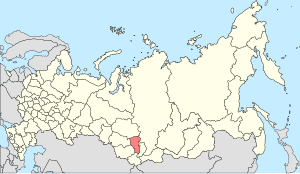South Central Siberia
This article needs additional citations for verification. (November 2008) |
South Central Siberia is a geographical region north of the point where Russia, China, Kazakhstan and Mongolia come together.

Kuznetsk Basin to the west and Minusinsk basin to the east.
Altai Republic to the south, Altai Krai northwest of that and Tuva to the southeast
The Four Corners


At approximately 49°8′8″N 87°33′46″E / 49.13556°N 87.56278°E, the borders of
The Altai mountains on the Russian side of the border have been designated a UNESCO World Heritage Site.[1]
South: Altai Republic
Above the "Four Corners" and in the southern part of South Central
Northern mountain range: Abakans and Kuznetsk Alatau
Northern South Central Siberia includes the Altai Republic, which is a 400 km projection of forested mountains which bends slightly to the west at the tip. It is called the Abakan Range in the south and Kuznetsk Alatau in the north. North of its northern end is the town of Tomsk.
West: Kuznetsk Depression
The west part of South Central Siberia includes the steppe of the Kuznetsk Depression, which contains the large Kuznetsk Basin coal fields, the mountains of the Abakans and Kuznetsk Alatau and the Salair Ridge which ends near Novosibirsk.
In the Soviet era, the Kuznetsk Basin coal fields were the largest Russian coal field after the Donets Basin. The name Kuznets means blacksmith and comes from the 'Blacksmith Tatars' or Shors, who were notable metal workers.
The Russians reached the area as early as 1618. The Abakans, Kuznetsk Alatau and the Kuznetsk Basin form the
East: Minusinsk Depression
The eastern part of South Central Siberia, between the Kuznetsk Alatau and the Sayan Mountains, includes the steppe of the
This area was a center of the
Southeast: Tuva
East of the Altai and southeast of Minusinsk is
The core area is the
Tuva was traditionally part of Mongolia, and only passed to the Soviet Union—Russia in the 20th century.
Surrounding area
To the north, South Central Siberia merges into the Siberian forests.
To the south, South Central Siberia merges into the mountains along the former Sino-Soviet border. Dzungaria is directly to the south.
To the west of South Central Siberia is the agricultural steppe of the
To the east, the Western and then Eastern Sayan Mountains extend east to the southern tip of Lake Baikal.
Other information
- Large cities in South Central Siberia include Novosibirsk on the Ob River, Tomsk north of the Kuznetsk Alatau, Krasnoyarsk north of the Minusinsk Depression on the Yenisei, and Barnaul on the steppe south of Novosibirsk.
- The Trans-Siberian Railway runs through this region from Novosibirsk to Krasnoyarsk.
- The area to the west is steppe or forest-steppe. The steppe curves around north of the Kuznetsk Alatau into the Minusinsk Depression. The land to the north and east is Taiga.
- The Russians first entered the area in about 1620. Seeking furs, they stayed in the forest area to the north. Massive peasant colonization of the steppe area only began after about 1860.
See also
- Altai-Sayan region
- Barabinsk Steppe
- Kanas Lake
- Great Lakes Depression
- Saylyugemsky National Park
- Shorsky National Park
- Denisova Cave
- Ukok Plateau
- Pazyryk Culture
- Lykov family
- South Siberian Mountains
References
- ^ UNESCO World Heritage Centre. "Golden Mountains of Altai - UNESCO World Heritage Centre". Whc.unesco.org. Retrieved 2019-11-08.
Further reading
- Forsyth, James, "A History of the Peoples of Siberia", 1992.
